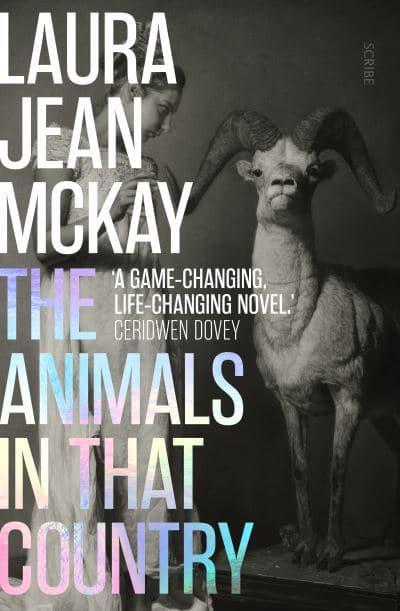“I thought my next novel was a gritty realist story. But the problem is if you write gritty realism now (in the way we usually think of realism), you’re writing historical or at least nostalgia fiction; and anything that used to be speculative is now realist. So what I’m working on has become rather speculative. I keep using that term – it’s not my favorite, but it’s what we have to describe what I think of as sideways fiction. ” (Laura Jean McKay, Write or Die November 2020.)

Jean works as a guide in an animal sanctuary. She is what might best be termed a tough cookie, battered by life, abandoned by her husband Graham and a barely functioning alcoholic. There are two things in life that keep her going: her passion for animals, and her love for her young granddaughter, Kimberley. Those, and her general bloody-mindedness. As this remarkable novel opens, Jean’s instinctive rapport with animals and her capacity for survival are both about to be tested in ways she could never previously have imagined.
There is a new disease sweeping the country, the so-called zooflu, a strain of influenza that clears up quickly but that leaves those infected with the ability to understand and intuit the thoughts and language of animals. Unlike simple hearing, this new form of understanding is bone-deep, felt in the skin and in the brain. For some, it takes on the aspect of a new religion; for others – many others – it is the gateway to madness. Driven insane by the ceaseless communications of insects, birds and fish, the worst afflicted resort to extreme measures to keep the psychic white noise out of their heads.
When Jean’s errant son Lee goes on the run with Kimberley, Jean is determined to find them and bring them home. She travels in the company of Sue, a dingo bitch she rescued as a pup, and who is capable of tracking Kimberley from hundreds of miles away. Ahead of Jean lie many obstacles, not least the toxic fallout from her own inner demons. But for once in her life, she is determined not to cock up.
I had a hard time getting to know Jean. She’s damaged, often illogical, a slave to her addiction. She’s also smart and ruthlessly determined, and by the time I reached the end of her story she and I had reached a better understanding. The fact that I found Jean difficult to like, not to mention bloody annoying at times, I count as testament to the skill of the author in creating a uniquely human, porous, breakable and thoroughly believable character. There are thousands of Jeans, and they won’t all make it. McKay does a magnificent job of fleshing out the why. Jean is unforgettable, though even more affecting is McKay’s imaginative rendition of animal thought-language, a feat of literary virtuosity that for me is the absolute highlight of this book, a form of rough, driven poetry that is as luminous as it is convincing.
The scenes with the pigs and cows. The Animals in That Country – the title is drawn from a poem by Margaret Atwood – would be necessary reading for those passages alone.
I suppose in that respect I am this novel’s natural audience. The ways in which the animals expressed themselves, hinting at sentient lives and independent consciousness beyond and apart from the human sphere, an alien realm in our midst did not seem at all unlikely to me. Rather, the thought-speech felt utterly right, an act of translation rather than imagination. (I guess I’m there with the spider.)
In talking about the novel’s use of speculative materials, it’s all in that quote from McKay that I’ve posted above, really. She has taken the threads of the life we are in the midst of and twisted them, just a little, to reveal the hidden trajectory of our realworld predicament. This, for me, is exactly what science fiction should be about, especially now. McKay wrote and sold Animals long before we knew what 2020/1 had in store for us; when she talks about the wearing of masks, the disinfecting of whole environments, the division of communities, the sudden, indelible shift in perspective that crisis brings, there is an extra frisson of the uncanny, a looming prescience that will colour and shape our understanding of her work.
It is this kind of prescience – a deep reading of the musculature of society, rather than a fixation on surfaces, on ‘stuff’ – that, again, makes The Animals in That Country radical and innovative science fiction. Its politics – a terse and unsparing examination of social and environmental inequalities – is integral to its being, its warp and weft. Not grafted on as a ‘theme’, but realised through keenly observed characterisation and active inter-character relationships.
This novel is as daring in its literary experimentation as in its speculative premise; proof, if any were needed, that no element of literary excellence need be sacrificed in the pursuit of science fictional innovation.
If only we could have seen James Bradley’s Ghost Species sitting alongside Animals on this year’s Clarke Award shortlist. And what is it about Aussie SF right now that seems to put it so far ahead of the curve?